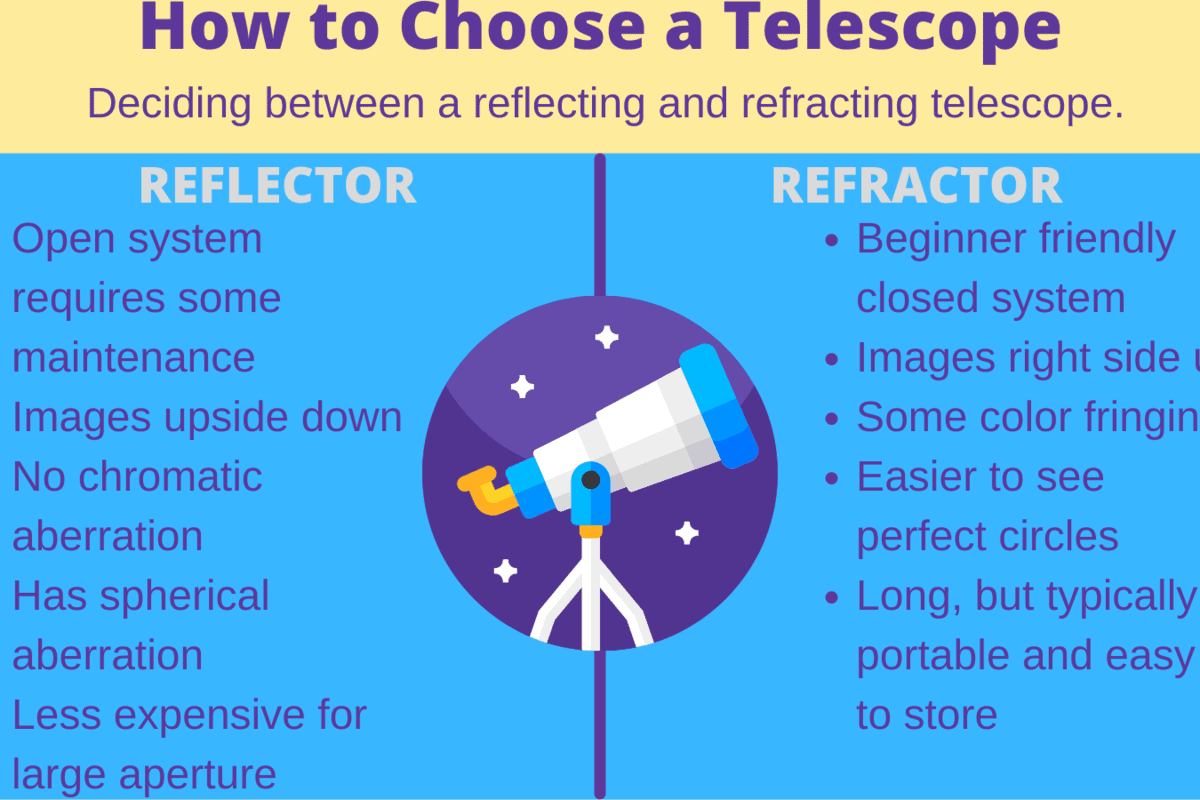a device that bends or refracts light, usually using a lens or a combination of lenses. It is commonly used in optics and astronomy to collect and focus light, making distant objects appear closer and clearer. The refractor is a fundamental instrument in telescopes, microscopes, cameras, and other optical devices. It is an essential tool for scientists, researchers, and professionals in various fields. The design and construction of refractors have evolved over the years, with advancements in technology and materials. Today, refractors offer high-quality images and precise measurements, making them indispensable in the study of the universe and the microscopic world.
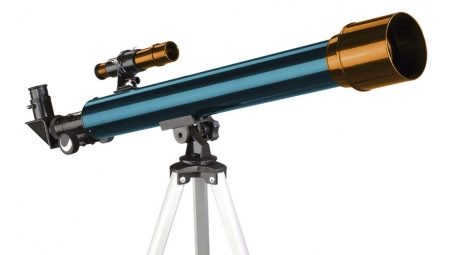
When people hear the word “telescope,” the first image that comes to mind is usually a refractor telescope. This type of optical instrument consists of a long tube and a lens. In this article, we will focus on providing more information about refractor telescopes.
What is this?
Let’s start with a little bit of theory. The main purpose of a telescope is to achieve maximum magnification and clear visualization of the object being observed. All instruments can be categorized into two types: reflectors and refractors. The most basic type of instrument is a refractor. The way they work is based on the refraction of light as it passes through the lenses.
The simplest models consist of a pair of lenses. One of these lenses acts as the objective lens, which is responsible for refracting the rays of light and focusing them to a single point. The other lens is a regular eyepiece, which allows the viewer to see the resulting image.
Therefore, the telescope device’s lens provides a greatly reduced view of the distant object. From this point, the image is transmitted to the eyepiece, which functions similarly to a magnifying glass. In certain models, the eyepiece is not aligned with the tube’s axis, but rather attached perpendicular to it. In such cases, the image from the lens is directed into the eyepiece through a refractive lens.
It’s important to understand the distinction between a refractor and a reflector telescope. The primary element of a reflector telescope is a concave mirror. It combines all the rays into a single beam and then, with the help of a system of additional mirrors and prisms, redirects it into the eyepiece. Some models also feature a perpendicular eyepiece equipped with a refracting lens.
The refractor telescope, known for its simplicity, is easily identifiable by its elongated tube design. One end of the tube is slightly widened to accommodate the receiving lens.
These models do not require any additional customization. Users simply need to adjust the focus of the camera. The optics have limited brightness, which can make it challenging to observe faintly luminous celestial bodies. However, on clear nights, refractor telescopes are ideal for viewing the Moon, paired stars, and planets.
Refractors offer several advantages:
- They have the ability to bring a large portion of collected light rays to the eyepiece. This sets them apart from mirror telescopes.
- The picture in refractors is clearer and brighter than in reflectors due to the higher light permeability.
- Refractors do not have a secondary mirror, which steals away part of the useful space of the lens. Additionally, the light rays in refractors are directed directly into the eyepiece without multiple reflections from mirrors, resulting in maintained clarity and contrast of the picture.
- All parts in refractors are firmly fixed, eliminating the need for adjustments. The housing is securely closed, providing effective protection against dust, which is not an advantage in reflectors.
However, refractors also have their own disadvantages.
This phenomenon has resulted in the unavailability of high magnification on inexpensive refractor models. Initially, astronomers attempted to combat chromatic aberration by creating telescopes with focal lengths of several meters.
By the way, this is something to keep in mind when selecting a telescope. The longer the tube, the better the image quality.
Refractors have a limited aperture. It is therefore recommended to purchase a model with a diameter of 120 mm or larger. However, beyond this threshold, the cost of optics significantly increases. Additionally, if the aperture is small, deep space objects will appear faint. As a result, refractors are primarily used for observing bright objects such as the Moon.
History of the Invention
In 1609, the renowned scientist Galileo invented the very first version of a telescopic refractor. Galileo, having discovered the creation of a telescope tube by the Dutch, managed to decipher its mechanism and used it as a basis to create the inaugural prototype of a telescope. This groundbreaking invention allowed people to explore and study the wonders of the celestial world. The diameter of this device was 4 cm, with a magnification of 3 and a focal length of approximately 50 cm.
Later on, the model underwent significant improvements. The diameter of the second refractor increased to 4.5, the focal length extended to 125 cm, and the magnification soared to 34.
Undoubtedly, it is unachievable to label that model flawless. In terms of its technical specifications, it significantly falls behind contemporary optics. However, notwithstanding this fact, during the initial two years of scrutinizing the celestial sphere, Galileo managed to detect blemishes on the Sun, mountains on the Moon, and even four satellites revolving around Jupiter. Furthermore, he also observed a duo of extensions encircling the planet Saturn. Nevertheless, the true essence of this extraordinary phenomenon eluded the scientist as it was later confirmed that these extensions are, in fact, rings enveloping the planet.
Categories of telescopes
Over the course of 400 years, refractor telescopes have undergone numerous improvements and advancements. Contemporary devices differ greatly from their initial designs. Let’s explore some of the most renowned variations.
The Galileo Telescope
The Galileo telescope was constructed using a dual-lens system. The dispersing lens served as an eyepiece, while the collecting lens functioned as the primary lens. This configuration produced a non-inverted, direct image. However, it also resulted in significant distortions. Presently, this model is not in high demand, although it can still be found in theater binoculars.
Kepler’s
In 1611, Johannes Kepler made slight improvements to Galileo’s invention. He modified the eyepiece by replacing the scattering lens with a collecting lens, which increased the field of view but resulted in an inverted image. One advantage of Kepler’s refractor was the presence of an intermediate image, allowing for the placement of a measurement scale within the device.
Essentially, all modern telescope models are based on Kepler tubes. The only drawback is the presence of chromatic aberration, which has been mitigated over the years by reducing the relative aperture of the tube.
In 1758, the situation took a turn when achromat refractors were invented in England. The original concept by Galileo was used as a foundation, but the lenses were modified – the achromatic optics design incorporated a specific pair of lenses with varying refractive properties. This innovation greatly reduced chromatic aberration.
However, it did not completely resolve the issue, as the iridescent fringe still remained noticeable.
Apochromat
The latest equipment available in the market are the apochromatic telescopes. These telescopes are considerably pricier compared to achromats, which is why they were not widely used until the 20th century. The apochromatic telescopes provide superior image quality, thanks to the utilization of special and costly materials. Advancements in technology have enabled the reduction of chromatic aberration in these telescopes. Only those with a keen eye for celestial observation can perceive a faint fringe, and even that is possible only under unfavorable viewing conditions.
Popular telescope models
Let’s take a closer look at the features of the most popular refractor telescope models.
Veber 360/50 AZ
This telescope is a perfect gift for beginners in astronomy. It provides a non-inverted image and is mounted on an easy-to-use azimuthal mount. This model is suitable for observing the planets of our solar system, studying lunar craters, and exploring terrestrial landscapes. It also allows you to view deep space, although the image may be less detailed.
It offers magnification ranging from 18x to 90x. This telescope is compact and lightweight, making it portable and easy to use. It comes with a hard case for transportation and storage.
Levenhuk Skyline BASE 50T
Here’s another option for children or beginner astronomers, perfect for their first introduction to the wonders of the night sky. This telescope is simple to assemble, and the kit includes all the necessary accessories to control the basic refractor. It’s even easy enough for children to handle and maintain. With its powerful optics, you’ll be able to observe planets, the Moon, and even terrestrial objects.
The lenses are made of glass and have been treated to provide excellent contrast and clarity, even at high magnification. To help you study celestial objects, this refractor comes with a 5x optical finder. This refractor inverts the image, so the kit also includes a diagonal mirror to correct the image orientation.
Azimuthal installation provides convenient operation and enables the refractor telescope to be aimed at the desired object with maximum speed. The optical equipment is securely mounted on a sturdy metal tripod with adjustable legs, ensuring that observers of any height can easily adjust the telescope to their preference. Moreover, the tripod is equipped with a handy accessory box that can hold essential items such as a compass, star map, extra eyepieces, and other necessary tools for optimal performance.
An ordinary telescope that is convenient to use. Provides a clear view of the Moon and objects on Earth. The model has the added benefit of including numerous filters and other accessories, eliminating the need for separate purchases.
Using this telescope enables beginner scientists to develop their sky navigation skills and gain a fundamental understanding of how optical equipment works.
The PolarStar II 700/80AZ model is highly sought after.
World’s Largest Modern Instruments
A refractor telescope assembled in Paris in 1900 for the World’s Fair holds the record for being the largest in size. Its objective lens had a diameter of 1.25 m, and the length of the tube exceeded 60 m. However, due to its immense weight and size, the telescope was fixed horizontally and stationary, preventing any observations. As a result, it was dismantled after 9 years.
The Yerkes Observatory in Chicago is home to the largest modern telescope. The objective lens of this telescope measures 1.1 meters, allowing for the study of distant objects in the solar system. This refractor was manufactured in 1897, coinciding with the opening of the Yerkes Observatory.
There are also refractor telescopes of significant size at various locations, such as the Potsdam Astrophysical Institute, Lick, Pulkovo, Greenwich Observatories, Nice, Archenhold, and Allegheny. One particularly renowned telescope is the James Clark Maxwell Telescope, which can be found in Hawaii, USA, situated at an impressive altitude of 4200 meters.
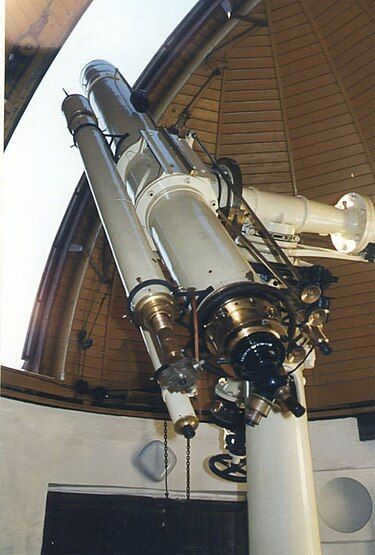
A Refractor is a specific kind of optical telescope that utilizes a pair of lenses in order to produce an image. These lenses include a convex objective lens (also known as a collecting lens) with a long focal length, as well as a concave eyepiece lens (also known as a diffusing lens) with a short focal length. By utilizing this type of configuration, a refractor telescope is capable of producing a straight image that is not inverted. Additionally, the image produced by a refractor telescope will be at its maximum level of sharpness when the distance between the eyepiece and the objective lens, also known as the tube length, is equal to the difference in their focal lengths. The magnification of the telescope can be determined by calculating the ratio of the focal lengths of the objective lens and the eyepiece.
Evolution of Invention
In 1611, Kepler put forward the idea of utilizing a positive (double-convex) lens positioned at a distance from the focus of the objective lens equivalent to its own focal length – instead of moving it towards the objective lens, he suggested moving it away from it. The overall length of this type of telescope is determined by the sum of the focal lengths of the objective and eyepiece. Although this design produces an inverted image, it offers a wider field of view and increased brightness [1].
The German geometer, astronomer, and physicist Christoph Scheiner was the first to design a telescope in 1613, and Keplerian tubes became popular in astronomy in the late 1630s. This marked the beginning of modern eyepieces, including those developed by Jesse Ramsden, Christiaan Huygens, and others. The introduction of positive eyepieces allowed for the use of filament crosses and screw ocular micrometers to make measurements. This advancement was suggested by W. Gascoigne in 1640. Using his instrument, he was able to measure the diameters of Mars and Jupiter [2].
After Galileo, the astronomer Jan Hevelius from Danzig made a remarkable discovery regarding the longitude libration of the Moon. Hevelius also conducted a detailed study of the Moon’s surface, which he documented in his renowned work called “Selenographin”. In the 1650s, Hevelius’s work was translated into Russian and included an exposition on the theories of Dutch and Keplerian telescopes. Hevelius played a significant role in popularizing telescopes in Russia [2]. In fact, telescopes were introduced there as early as 1614, shortly after their invention. By the mid-17th century, telescopes were readily available for purchase in Moscow’s trading districts.
In 1729, a discovery was made that it was feasible to compensate for deficiencies by utilizing two lenses composed of different types of glass: a convex lens made of flintglass, which is an optical glass with a high refractive index and low dispersion, and a concave lens made of kronglass, which has a low refractive index and medium dispersion. This concept was initially proposed in 1695 by David Gregory, a professor of mathematics at Oxford, and later implemented by Chester Moore Hall, an English lawyer and amateur astronomer.
There are four potential variations of these lenses made of kronglass and flintglass, which include lenses that are tightly fitted and can be either glued, Garting lenses, Fraunhofer lenses, or lenses with an air gap.
Astronomers began developing “airborne” telescopes in order to increase the focal lengths of lenses. These telescopes featured separate tripods for the objective and eyepiece, allowing them to be mounted independently of each other. The lens was positioned along the line of sight, and astronomers would observe the image from a distance of several meters. Despite the challenges associated with using these telescopes, they were produced until the mid-18th century. However, the pursuit of alternative designs eventually encountered insurmountable technical obstacles.
Design and operation principles
Galileo telescope
Kepler telescope
Discoveries made using refractor telescopes
Galileo used his invention to explore craters and measure the height of mountains on the Moon. He also discovered the phenomenon of libration and made assumptions about the rings of Saturn. Additionally, he discovered four satellites of Jupiter and observed sunspots.
Simon Marius observed a phenomenon known as “running shadows” or “Marius flicker” on the lens of the telescope without the eyepiece. He also discovered the presence of phases in the planet Mercury.
In 1618, Johannes Cisat discovered a gas-dust nebula in the Orion constellation belt. This nebula was later studied by Christiaan Huygens.
In 1643, Giovanni Riccioli observed shadows from satellites on Jupiter’s surface through a telescope and made the groundbreaking discovery of the duality of the star Zeta in the Big Dipper constellation.
Moving forward to 1655, Christian Huygens examined Saturn and became convinced that the planet was surrounded by a unique and intriguing feature—a “thin, flat, free-floating, ecliptic-tilted ring.” During his observations, he also discovered Saturn’s sixth satellite, which he named Titan. Additionally, Huygens documented the presence of spots and other formations on Mars, shedding light on the planet’s characteristics. Furthermore, he described the mesmerizing Orion Nebula.
Jumping ahead to 1728, Italian astronomer Francesco Bianchini made an important observation regarding Venus. Despite the planet’s blurred details on its disk, Bianchini was able to discern its axial rotation, determining a period of approximately 24.3 Earth days.
Lastly, in 1892, Edward Emerson Barnard utilized the Lycian telescope to make a significant discovery. He identified Jupiter’s satellite Amalthea, adding to our understanding of the planet’s celestial companions.
The most enormous refractors
- The colossal telescope of the Paris Exposition of 1900 (1.25 meters or 49 inches) – disassembled after the Exposition
- Yerkes Observatory (101.6 cm or 40 inches)
- First Solar Telescope of Sweden (98 cm or 39 inches)
- Lick Observatory (91 cm or 36 inches)
- Great Refractor of the Paris Observatory Medon (83 cm (33 inches), +62 cm (24 inches))
- Potsdam Great Refractor (80 cm (31 inches), + 50 cm (20 inches))
- Nice Observatory (77 cm or 30 inches)
- John Wall (76.20 cm or 30 inches) dialite refractor, the most massive refractor constructed by man at the Hanwell Community Observatory
- Grubb's 28-inch refractor at the Royal Greenwich Observatory, Aperture Lens (71 centimeters or 28 inches)
- Vienna Observatory’s Great Refractor, (69 centimeters or 27 inches)
- The Archenhold Observatory boasts the record of having the longest refractor telescope ever constructed, with a focal length of 68 cm (27 inches) and a length of 21 m (69 feet).
- The U.S. Naval Observatory is home to a refractor telescope that measures 66 centimeters (26 inches) in length.
- At the National Observatory of Athens, you can find the Newall Refractor, which has a length of 62.5 centimeters (24.6 inches).
- The Lowell Observatory is equipped with a refractor telescope that measures 61 centimeters (24 inches) in length.
Notes
- ↑Alexei Levin.A glimpse into the celestial realm // Popular mechanics: Journal. – 2009. – No. 9.
- ↑ 2,02,1Melnikov O.A. The contemporary telescope. – Moscow: Nauka, 1968. – 326 p.
- ↑ 3,03,1Dimitrov Georg, Becker Jams. Telescopes and their accompanying tools. – Moscow, L.: OGIZ-Gostekhizdat, 1947. – 309 p.
This article has been marked as “finished”. This does not indicate the quality of the article, but it already covers the main topic sufficiently. If you would like to enhance the article, feel free to edit it!
A refractor telescope is composed of two lenses which bend light rays: a larger one at the front (called the objective lens) and a smaller one at the back (called the eyepiece). The objective lens creates a much smaller image of the faraway object being observed.
A reflector telescope, on the other hand, uses a mirror positioned at the “bottom” of the tube. A reflector telescope is distinct from a refractor telescope because it lacks a solid tube.
What sets the designs apart?
The construction of refractors (1) is hindered by the challenge of machining a lens, particularly a sizable one, to a high standard. In contrast, the production of concave mirrors, which form the foundation of reflectors (2), is relatively straightforward compared to making lenses for refractors. Refractors typically offer superior image clarity and less distortion.
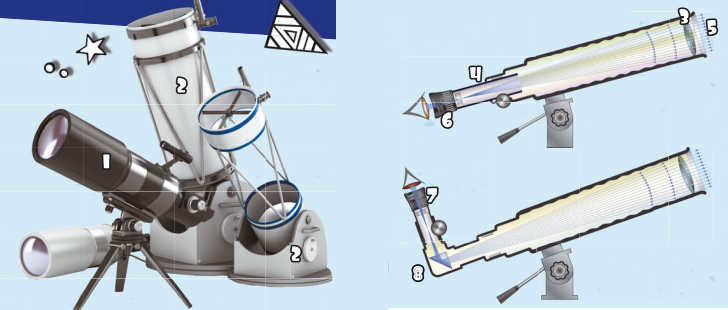
What is the functioning principle of a refractor?
In a refractor telescope, a distant object of observation (5) is magnified by the objective lens (3) and a reduced image (4) is produced. This image is then observed through the eyepiece (6) similar to using a magnifying glass. In some variations, the eyepiece is positioned at a perpendicular angle (7) to the tube axis, and the image from the lens is transmitted to the eyepiece through a refracting lens (8).
What is the mechanism behind the functioning of a reflector?
When it comes to reflector telescopes, the working principle involves the usage of a concave mirror (9) that gathers light rays (10) and focuses them into a concentrated beam. This beam is subsequently directed to the eyepiece (12) with the assistance of auxiliary lenses and mirrors (11). Similar to refractors, certain reflectors are equipped with a perpendicular eyepiece (13) and an extra refracting lens (14).
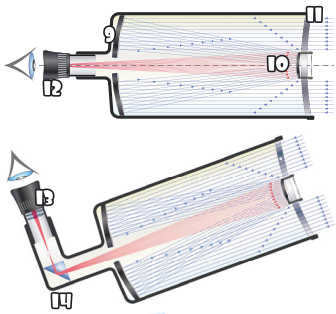
Paris Giant
The 1900 World's Fair in Paris witnessed the creation of an exceptional refractor telescope. Boasting a lens diameter of 1.25 meters and a tube length of over 60 meters, this telescope set new records. However, its immense size and weight made it impractical for regular use, leading to its horizontal and stationary mounting. This proved to be inconvenient, and in 1909, the telescope was disassembled.
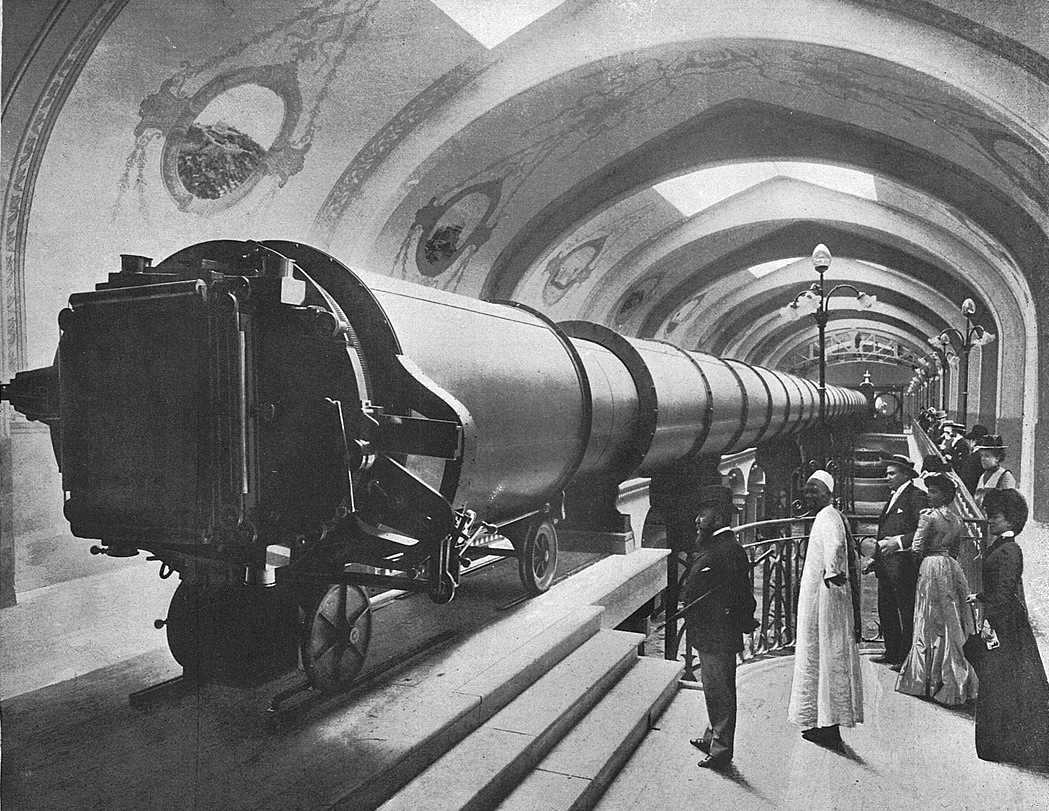
The extraordinary reflector
Refractor telescopes pale in comparison to the immense size of reflector telescopes. Nestled within the expansive confines of the Roque de los Muchachos Observatory in the Canary Islands, resides the remarkable Great Canary Telescope, boasting the world’s largest mirror. This incredible observatory was constructed in 2007 and houses a mirror with a diameter of 10.4 meters, a staggering ten times larger than the lens found in the largest refractor telescope!

Unprecedented refractor
The Yerkes Observatory of the University of Chicago (USA) houses the largest refractor telescope ever created. Its lens boasts a remarkable diameter of 1.02 meters, enabling astronomers to observe even the most remote entities within our Solar System. The establishment of the Yerkes Observatory dates back to 1897, coinciding with the installation of this groundbreaking telescope.
The topic of whether refractors or reflectors are better has long been a subject of intense discussion. It is important to note that when we talk about the advantages of refractors and reflectors, we are not referring to cases where one type of instrument clearly outshines the other, such as the use of refractors for measuring work or large reflectors for astrophysical research. Instead, we are comparing the fundamental characteristics of these instruments, which stem from the fact that refractors utilize a lens while reflectors use a mirror.
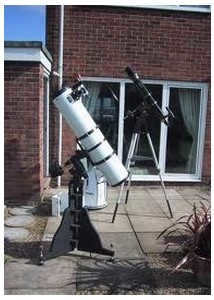
Key benefits of the refractor include:
- The refractor lens is always ready for use and maintains its integrity over time, unlike the mirror which gradually deteriorates. Although the current aluminum coating is highly stable, it will eventually degrade.
- The refractor lens is less susceptible to deformations caused by gravity, as any shape changes on one surface are counterbalanced by opposite changes on the other surface. In contrast, reflectors with a single reflective working surface can experience mirror deflections and temperature distortions that significantly impact image quality.
- The refractor is securely sealed, which provides a significant advantage. Not only does it protect the internal components from dust, but more importantly, it prevents the formation of air currents of varying densities that can degrade the image quality.
Drawbacks of the refractor:
- The refractor is always prone to chromatic aberration, which is a significant disadvantage. The reduction of secondary spectrum can only be achieved through the use of specialized glasses, but this comes at a great cost. It results in a decrease in the relative aperture, a decrease in lens durability (due to the use of easily weathered glass varieties), and an increase in lens curvature and thickness.
- A refractor’s relative aperture (aperture power) should not exceed 1:15 – 1:18 to maintain image quality, often even smaller, which is insufficient for many tasks.
Advantages of a refractor:
- Complete achromaticity allows for achieving a perfect image by shaping the mirrors’ surfaces precisely.
- Due to its complete achromaticity, a reflector can have a larger relative aperture (aperture) of up to 1:3, which is unattainable for a refractor. A larger relative aperture enables the observation of dim astronomical objects like galaxies and nebulae, as well as distant planets (Uranus, Neptune, Pluto). It also allows for a shorter instrument length, making the mechanical part of the instrument lighter.
- The mirror material should only meet the mechanical requirement in terms of quality. The challenges related to optical homogeneity of the glass, which are crucial in making refractor lenses, are completely eliminated in this case, resulting in cost savings.
- Expanding the diameter of the refractor lens does not result in any increase in light loss. Furthermore, the mirror used in reflector telescopes can reflect rays of any wavelength, including ultraviolet, which is essential for astrophysical observations.
Disadvantages of using a reflector:
- Not suitable for precise astrometric work.
- Requires a perfectly accurate mirror surface, preferably parabolic.
- Susceptible to mirror deflections and deformations due to changes in temperature.
- A major drawback of reflectors is that their tubes are open, allowing for air currents of varying density inside the tube, which can distort the image.
- The reflective surfaces of mirrors are fragile and require regular restoration.
- The secondary mirror causes light loss.
Now, let’s explore a crucial question for amateur astronomers: what are the advantages and disadvantages of small refractors and reflectors?
The primary question we must address is: what are the comparative light losses in a refractor versus a reflector? The light loss breakdown is as follows: 10% is lost on the aluminized mirror, while 20% is lost in the achromatic refractor. Additionally, it is important to note that in the reflector, some light is lost due to the closure of the central part of the main mirror by the secondary mirror.
The second concern revolves around the field of view, which typically favors the refractor.
Thirdly, during transportation, the refractor’s alignment may become disrupted.
Comparing a small reflector to a refractor, the advantages lie in its ability to produce brighter and clearer images, particularly of extended objects such as planets.

If you have an interest in astronomy, you will eventually realize that owning your own telescope is essential. There are numerous stores that offer telescopes for sale. However, the dilemma arises: should you choose a store that sells pre-made telescopes or a laboratory that can custom build a telescope to meet your specific needs? Selecting the right equipment for astronomical observation is a complex matter. It is important to note that there is no one-size-fits-all telescope for all types of observations. Each telescope is specifically designed for a particular type of observation. Therefore, before purchasing a telescope, it is crucial to first determine why you need one and what kind of observations you intend to make with it.
When it comes to buying a telescope, this is undoubtedly the most important question to consider. In this article, we will strive to provide an unbiased analysis of the pros and cons of refractor telescopes and reflector telescopes. Currently, there seems to be a clear divide between two groups: those who advocate for refractors and those who advocate for reflectors.
Refractor telescope
A refractor is a type of telescope that utilizes a series of lenses to gather light.
There are several advantages to using a refractor telescope:
– Long lifespan;
– Stable centering;
– Wide field of view;
– Minimal light loss (as there are no additional surfaces between the lens and eyepiece);
– Superior image quality (due to the absence of additional diffraction phenomena caused by extra surfaces);
– Effective protection against dust and the detrimental effects of varying air densities, which can impact image quality (as the refractor is tightly sealed).
However, there are also some drawbacks to consider:
– The reduction in image sharpness and the appearance of colored contours, stripes, and spots is known as chromatic aberration;
– The relative aperture of reflector telescopes is very small, usually around 1:15 – 1:18 or less, resulting in a small aperture value;
– Reflector telescopes have impressive dimensions.
Reflector Telescope
A reflector telescope uses mirrors to collect light.
Advantages of reflector telescopes include:
– They offer complete achromaticity;
– They allow for a large relative aperture, up to 1:3, resulting in a large aperture;
– They are compact in size;
– They are more affordable compared to other types of telescopes.
Disadvantages of reflector telescopes include:

